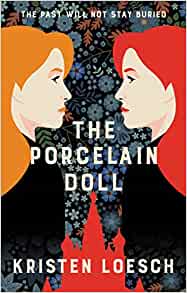The Stories Behind the Story: How The Porcelain Doll Became a Novel About Fairy Tales, Epic Love, and Yes, Russian Dolls (But Not That Kind)
By Kristen Loesch
 When I was a kid in the 1990s, my father, who moonlighted as a martial artist, began to train with elements of the Russian military in Moscow. He would often be away for months, returning with fascinating trinkets and stories that made this faraway country seem like a fairy tale. I don’t think it ever lost that fairy-tale quality, even after I began reading classical Russian literature in earnest, after I began studying Russian language, after I became a postgraduate in Slavonic Studies.
When I was a kid in the 1990s, my father, who moonlighted as a martial artist, began to train with elements of the Russian military in Moscow. He would often be away for months, returning with fascinating trinkets and stories that made this faraway country seem like a fairy tale. I don’t think it ever lost that fairy-tale quality, even after I began reading classical Russian literature in earnest, after I began studying Russian language, after I became a postgraduate in Slavonic Studies.
All my life I had been told that my grandfather, who hailed from the far north of China, was part Russian. One of my very early works of fiction was a short story in which his mother – my great-grandmother – was in fact the long-lost Princess Anastasia. In the story, she escapes the Bolsheviks and the execution of her family; she makes her lonely way across Siberia, driven by desperation; she crosses the border into Mongolia; entering China, she meets and eventually falls in love with my great-grandfather. This would have been in the early 1920s. Nobody knows when my grandfather was born. He had no birth certificate. But he was a young man when he fled China in 1949. The timing, if nothing else about this particular fairy tale, checks out.
*
Although I did my Master’s degree in Russian politics – as well as not-quite-half of a PhD – The Porcelain Doll is not based on the bulk of that research, which was mostly to do with civil society in post-Soviet Russia. It’s much more the product of lifelong curiosity and passion for Russian novels, particularly the most famous, epic love stories of the late 19th century and early 20th. In The Porcelain Doll, there is homage after homage to these stories, some more overt, and some that would require significant digging (or excessive familiarity with the works in question). This ranges from characters’ names, to locations, to subtle allusions in dialogue. There’s no need for anyone to have read any of those books, however, to understand the story. Far from it.
I think writing The Porcelain Doll became a form of catharsis, at some point; here I had spent so many years of my life reading about Russia, studying Russia, and finally, I had an outlet. The fact that the novel has such a sweeping timeline – it spans the entire history of Soviet Russia, from inception to collapse – has partly to do with how the literary part of me wanted to write about the revolutions, about the end of Imperial Russia. The more pragmatic part was thinking, well, yeah, but you know more about the post-Soviet period. Maybe there’s a middle ground? Evidently there is. About seventy-four years, to be exact. And that turned out to be where I found my story.
*
My grandmother loved matryoshkas. She had an entire table covered with them. I spent a lot of time with my grandmother in the final years of her life; these were also the years I worked on the early drafts of The Porcelain Doll. At some point it occurred to me, as my story was shaping up to be a family saga set in Russia, about three generations of women, that matryoshkas made perfect sense as a central motif. In fact, I’ve since then read a breathtaking historical novel, The Nesting Dolls by Alina Adams, which makes heavy use of matryoshka-symbolism, and it is beautifully done.
In the end, however, for my novel, matryoshkas felt too nice. (When it comes to Russian craftsmanship, anyway, I prefer painted lacquer boxes.) Matryoshkas are beautiful in an unintrusive way, while I wanted a touch of the gothic, of the eerie. That – and the role of a talking wooden doll in one of the most famous Russian fairy tales of all time, Vasilisa the Beautiful – was how I decided to weave porcelain dolls into the story. The more I write, the more I’m discovering my love of the uncanny; it’s seeping into all my forms of fiction.
*
One of the grimmest discoveries of my young life was that the inside of a porcelain doll’s head is hollow. You can reveal it by removing the “pate”, the upper portion of the scalp, which is usually glued both to the doll and to the wig of hair. (There are Youtube videos where people make planters out of old dolls!) Though they are overshadowed by the ubiquitous matryoshka, porcelain dolls were produced throughout the lifespan of Soviet Russia. They are The Other Russian Dolls (as a recent non-fiction guide by Linda Holderbaum explains in full).
As a child, I was taken to visit a family friend who had rooms full of collectible items. I still recall walking into her “doll room”: Dolls on the chairs, on the bed, faced out the windows. In my memory, all the doll-heads swiveled towards me; of course that was my youthful imagination. Doll-heads can’t turn like that (many do turn! But not very far). They can, however, open – at least through their heads – and somebody, somewhere, maybe a character in my novel, might think of hiding something inside…
—
Kristen Loesch grew up in San Francisco. She holds a BA in History, as well as a Master’s degree in Slavonic Studies from the University of Cambridge. Her debut historical novel, THE PORCELAIN DOLL, was shortlisted for the Caledonia Novel Award and longlisted for the Bath Novel Award. After a decade living in Europe, she now resides in the Pacific Northwest with her husband and children. THE PORCELAIN DOLL is out in February 2022 in the UK (Allison & Busby), to be followed by publication in the US (Berkley) and several other territories in 2023.
Find out more about her on her website https://www.kristenloesch.com/
Follow her on Twitter https://twitter.com/kristenloesch
THE PORCELAIN DOLL
 A masterful debut’ – Ellen Alpsten, author of Tsarina
A masterful debut’ – Ellen Alpsten, author of Tsarina
In a faraway kingdom, in a long-ago land …
… Rosie lived peacefully in Moscow and her mother told her fairy tales. One summer night, all that came abruptly to an end when her father and sister were gunned down. Now, Rosie’s only inheritance from her reclusive mother is a notebook full of eerie, handwritten tales, but there is another story lurking between the lines.
Currently studying at Oxford University, Rosie has a fiancé who knows nothing of her former life. Desperate for answers to the questions that have tormented her, Rosie returns to her homeland and uncovers a devastating family history which spans the 1917 Revolution, the siege of Leningrad, Stalin’s purges and beyond.
At the heart of those answers stands a young noblewoman, Tonya, as pretty as a porcelain doll, whose actions reverberate across the century …
BUY HERE
Category: On Writing























